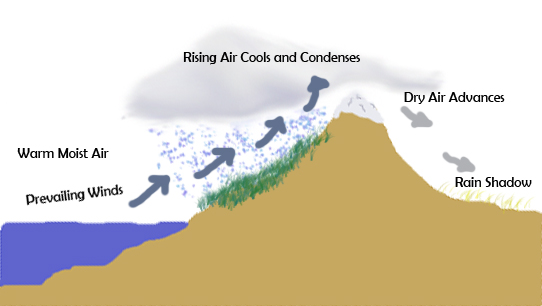Precipitation Tutorial
Precipitation is an important part of the water cycle. Sunlight evaporates water from the ocean and other waterbodies, from soils, and from plants through transpiration. This warm, moist air rises and eventually cools; the water it carries condenses, forms clouds, and, ultimately, precipitates. Specifically, precipitation occurs when air masses become saturated with moisture, and the condensation of water vapour leads to water droplets that fall to the earth.
While this is going on, the air masses are moving within the atmosphere and over the landscape, which affects where and how the precipitation occurs. For example, moisture-laden air masses are cooled as prevailing winds force them over mountains, leading to condensation and precipitation on the windward slopes – orographic precipitation.

Source: http://en.wikipedia.org/wiki/Image:Rainshadow_copy.jpg
The climate on the leeward side of the mountain is drier – the region is said to be in a rain shadow.
Similarly, frontal rainfall occurs when a warm air mass rises over a cold air mass, leading to cooling, condensation, and rainfall.
The form of precipitation – rain, snow, hail – depends on both the temperature of the atmosphere where it is formed, and the temperature nearer the earth’s surface:
- Rain occurs when moisture condenses into water droplets, or when hail or snow melt while passing through warmer air before reaching the earth.
- Hail is formed in storm clouds, when water freezes on contact with some sort of particle such as a snowflake or a dust particle. Ice layers accumulate as the hailstone circulates inside the cloud; the hailstone falls to the earth when it becomes too large for updrafts to sustain its weight.
- Snow is formed when water vapour condenses directly into ice crystals. Snowflakes, aggregates of these crystals, fall to the earth when temperatures remain below 0° C during their descent.








